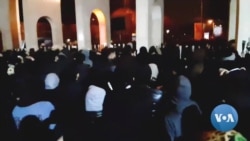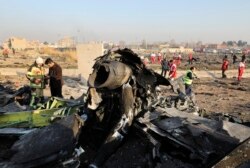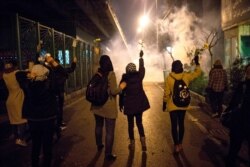Days of protests against Iranian leaders over the accidental downing of a Ukrainian airliner appear to indicate public anger has been redirected away from America's targeted killing of a top Iranian general. But foreign policy analysts say it is too early to tell if this is the beginning of a broader popular movement.
"My expectation is that the demonstrations, however large they may be, are really not huge and are really not likely to metastasize a lot more," said Michael O'Hanlon, a senior fellow at the Brookings Institution.
The demonstrations erupted Saturday in the capital and other cities after Iranian officials admitted the military shot down a civilian plane, a Ukraine International Airlines Boeing 737, shortly after takeoff from Tehran that was bound for Kyiv on Jan. 8. All 176 people on board were killed. Most of the passengers were Iranian citizens or of Iranian descent. For three days, Iran insisted that mechanical problems likely caused the plane to crash before acknowledging the truth.
Recently uncovered security camera footage shows two Iranian missiles hitting the plane. They were fired 30 seconds apart and launched from an Islamic Revolutionary Guards Corps' airspace unit 12 kilometers from the Tehran airport.
The accidental downing of the airliner occurred on the same night Iran launched a retaliatory missile strike against a U.S. military base in Iraq for the targeted U.S. killing of General Qassem Soleimani, a high-ranking leader of the Islamic Revolutionary Guard Corps.
Conflicting grievances
The fact that Iran warned of its imminent missile strike against the United States, which helped prevent American causalities, while not taking precautions to prevent the accidental strike against a civilian airliner, has fueled public outrage.
"I think the failure of the government to suspend air traffic, civilian air traffic at a time of heightened tensions with the United States, has really created the sense of anger," said Ali Vaez, the director of the International Crisis Group's Iran Project.
Videos widely shared on social media showed Iranian demonstrators in the hundreds. In one, a group of protesters chant "down with the dictator," while in another, crowds cheer as a man tears down a meters-tall picture of Soleimani that was put up during his funeral.
The anti-government protests that have gone on for four days now, Vaez said, "evaporated this sense of national unity" that came together during Soleimani's massive funeral, where mourners called for revenge against the U.S., and where a number of people were killed and injured when a stampede broke out in the crowd.
This recent outpouring of both anti-government and anti-American sentiment exposes, in some ways, the conflicted grievances held by Iranians, at both increasing repression at home and U.S. actions, particularly under U.S. President Donald Trump, to impose harsh economic sanctions, to align more closely with rival Saudi Arabia and to impose a travel ban that targets Iranians.
"The Iranians feel that they're stuck between a very aggressive United States and a very repressive Islamic republic, that basically none of these governments really care about them," Vaez said.
Past protests
Recent protest video also show riot police firing tear gas into crowds. At least 30 protesters have been arrested.
Iranian Foreign Minister Mohammad Javad Zarif said Wednesday that while people are "free to state their views," the protests this week have been "excessive."
Protests against the Islamist, authoritarian government in Iran have flared multiple times in recent years, often led by young people calling for democratic reforms and greater political freedom or rallying against the increasing economic hardships caused in part by U.S. sanctions.
In November, widespread protests erupted after the government announced a 50 percent increase in gasoline prices. There were reports that Iranian security forces fired live ammunition into some crowds of unarmed demonstrators.
The Human Rights World Report 2020 criticized the Iranian government for using "mass arrests and lethal force" to curtail protests.
"The regime has a great history of cracking down hard, whenever threatened. And it is yet to be seen whether these protests in any way can overcome that kind of threat," said William Wechsler, the Middle East Programs director at the Atlantic Council.
Iran defiant
Since Trump unilaterally withdrew from the landmark 2015 agreement that curbed Iran's nuclear program for sanctions relief, the country has come under increasing economic and political pressure. The U.S. has increased Iran sanctions in hopes of negotiating a nuclear deal that would also curb its ballistic missile program and end support for militias in the region.
Both the U.S. and Iran have indicated they want to avoid direct military conflict after the targeted killing of Soleimani and the Iranian missile strike against a U.S. base in Iraq.
However, neither the growing discontent at home, nor increasing tension with the U.S. has seemed to weaken the Islamic leadership's hold on power in Iran.
"I see Iran as a complex political entity, but still an autocracy with a very powerful state that knows how to control things within its own borders, and also to cause a lot of mischief abroad," O'Hanlon said.
Iranian President Hassan Rouhani on Wednesday blamed the U.S. and its allies for causing insecurity in the Middle East. Iran recently announced it will no longer adhere to the nuclear deal restricting enriched uranium development ostensibly for electrical power generation. Rouhani also reiterated a longstanding position that Iran does not seek a nuclear bomb.
But such a violation of the 2015 nuclear deal has triggered a dispute mechanism that could "snapback" both United Nations and European Union sanctions against Iran.
Gholamreza Allahyari of the VOA Persian Service contributed to this report.














